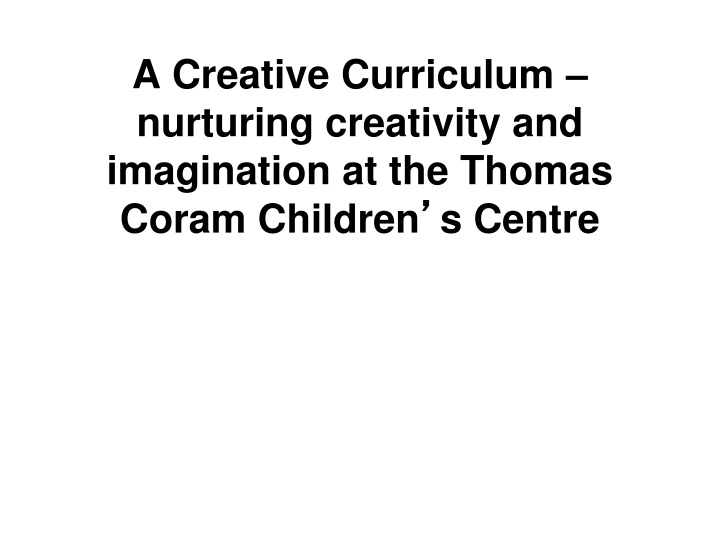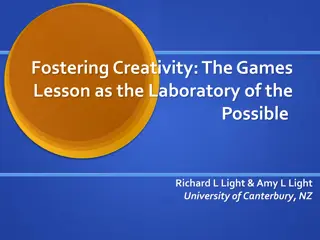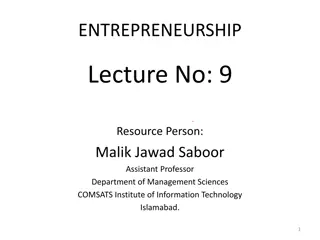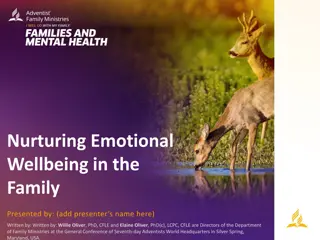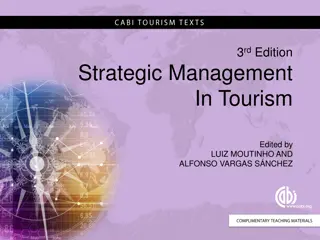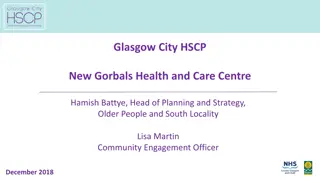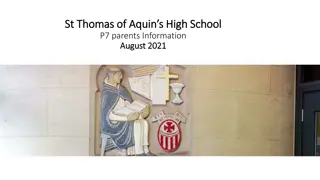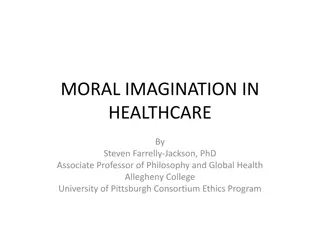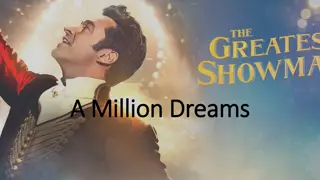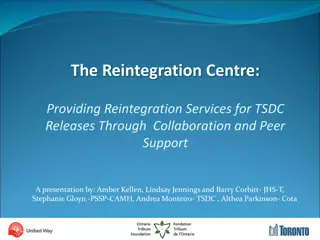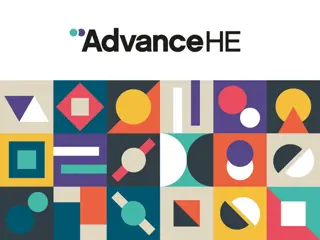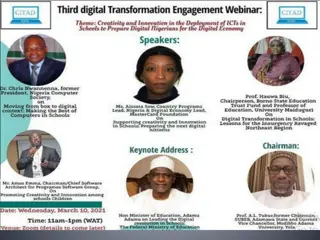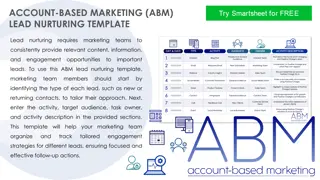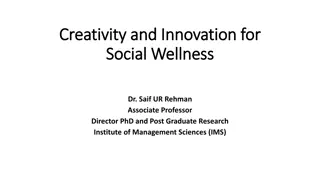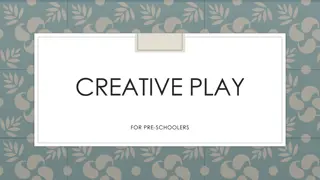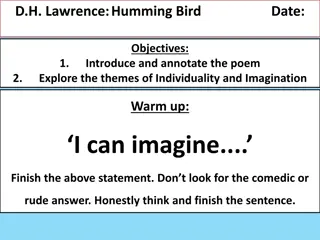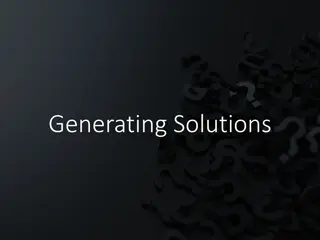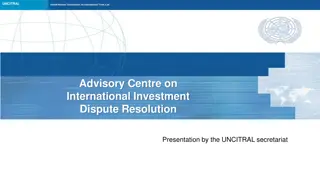Nurturing Creativity and Imagination at Thomas Coram Children's Centre
Delve into the importance of creativity for children, exploring the role of the Early Years Foundation Stage (EYFS) in supporting children's development. Learn about creating environments that foster creativity, working with artists, and enhancing the culture of creativity at Thomas Coram. Bernadette Duffy, an expert in early childhood education, shares insights on supporting creativity and imagination in the early years.
Download Presentation

Please find below an Image/Link to download the presentation.
The content on the website is provided AS IS for your information and personal use only. It may not be sold, licensed, or shared on other websites without obtaining consent from the author.If you encounter any issues during the download, it is possible that the publisher has removed the file from their server.
You are allowed to download the files provided on this website for personal or commercial use, subject to the condition that they are used lawfully. All files are the property of their respective owners.
The content on the website is provided AS IS for your information and personal use only. It may not be sold, licensed, or shared on other websites without obtaining consent from the author.
E N D
Presentation Transcript
A Creative Curriculum nurturing creativity and imagination at the Thomas Coram Children s Centre
Introduction Bernadette Duffy Head of Thomas Coram Centre for Children and Families Chair of the British Association for Early Childhood Education Author of Supporting Creativity and Imagination in the Early Years
Today we will be looking at the work we have been doing at Thomas Coram on:- The importance of creativity for children Being a creative practitioner Creating an environment that encourages creativity Working with artists and others to encourage a culture of creativity
Part One The importance of creativity for children
England and the EYFS The aim of EYFS is to:- Increase coherence, provide a flexible approach to care and learning and raise quality and play a key role in improving the life chances of all children End the sometimes unhelpful distinction between care and learning and between birth-to-three and three-to-five provision. Help us see children s learning and development as a process starting at birth
EYFS Principles A Unique Child Every child is a competent learner from birth who can be resilient, capable, confident and self-assured Positive Relationships Children learn to be strong and independent from a base of loving and secure relationships with parents and/or a key person Enabling Environments The environment plays a key role in supporting and extending children s development and learning Learning and Development Children develop and learn in different ways and at different rates and all areas of learning and development are equally important and inter-connected Child People Contexts Curriculum 1. 1 Child Development A Unique Individual A Skilful Communicator A Competent learner 2.1 Respecting Each Other Understanding feelings Friendships Professional Relationships 3.1 Observation, Assessment and Planning Starting with the Child Planning Assessment 4.1 Play and Exploration Learning through Experience Adult Involvement Dispositions for Learning 1.2 Inclusive Practice Children s Rights Equality and Diversity Early Support 2.2 Parents as Partners Respecting diversity Communication Learning Together 3.2 The Learning Environment Children s Needs The Learning Journey Working Together 4.2 Active Learning Mental and Physical Involvement Decision Making Personalised Learning 1. 3 Keeping Safe Being Safe and Protected Discovering Boundaries Making Choices 2.3 Supporting Learning Positive Interactions Listening to Children Effective Teaching 3.3 The Physical Environment The Outdoor Environment The Indoor Environment The Emotional Environment 4.3 Creativity and Critical Thinking Making Connections Transforming Understanding Sustained Shared Thinking 1. 4 Health and Well Being Emotional Well-being Growing and Developing Physical Well-being 2.4 Key Person Secure Attachment Shared Care Independence through Support 3.4 The Wider Context Transitions and continuity Multi-agency working The Community 4.4 4.10 Areas of Learning and Development Personal, Social and Emotional Communication, Language and Literacy Problem Solving, Reasoning and Numeracy Knowledge and Understanding of the World Creative Physical
The EYFS and Creativity 4.1 Play and Exploration Learning through Experience Adult Involvement Dispositions for Learning 4.3 Creativity and Critical Thinking Making Connections Transforming Understanding Sustained Shared Thinking 4.2 Active Learning Mental and Physical Involvement Decision Making Personalised Learning 4.4 4.10 Areas of Learning and Development Personal, Social and Emotional, Communication, Language and Literacy, Problem Solving, Reasoning and Numeracy , Knowledge and Understanding of the World , Creative , Physical
Children s creativity must be extended by the provision and offered support for their curiosity, exploration and play. They must be provided with opportunities to explore and share their thoughts, ideas and feelings, for example, through a variety of art, music, movement, dance, imaginative and role-play activities, mathematics, and design and technology. [EYFS 2007 Practice Guidance p 104] Practitioners ensure that children have the opportunity to develop the following aspects of creativity:- Being Creative Responding to Experiences, Expressing and Communicating Ideas Exploring Media and Materials Creating Music and Dance Developing Imagination and Imaginative Play
What is creativity We have been influenced by Anna Craft s work on - Big c and little c creativity Creativity enables individuals to find routes and paths to travel...It is a process of conscious invention and describes the resourcefulness of ordinary people rather than extraordinary contributors. It is about:- thinking along unorthodox lines breaking barriers using non-traditional approaches to problems. making new connections
Through creativity we:- Promote the full range of human potential Explore values and ways of working Understand our own and other cultures Respond Experiment
Why is it important Through their creativity children:- Express their thoughts Think about and create new meanings Solve problem and gain mastery Gain self esteem Create their own view of the world
The creative process Curiosity Exploration Play Creativity
The difference between Representation and Reproduction
How we use the arts to promote all areas of learning Personal Social and Emotional 1.Concentration, staying on task , problem-solving , planning and seeing things through to completion 2.Representing experiences, feelings and thoughts . 3Learning to share, interact and relate to others through meaningful experiences. 4.The creative processes that links children with the idea of creation in world religions. 5 Exposure to the arts helps children learn about their own and other cultures 6A sense of self-respect and valuing of others. . Communication , Language and Literacy 1.Opportunities to speak and listen , for example when negotiating roles and sharing resources 2.Understanding the elements of music ,such as rhythm and pitch , from which develops children's ability to speak 3.Understanding the process of representation which leads to understanding the symbolic nature of written language 4.The fine motor skills which are needed for writing . 5.The narrative skills necessary for storytelling , Problem Solving, Reasoning and numeracy 1.understanding patterns in two and three dimensional representations which helps children to identify number patterns later on 2.concepts of shape, size, line, and area which they will use to classify and sort objects 3.the opportunity to explore spatial concepts through block play and other forms of three dimensional representation 4.the opportunity to explore measurement in meaning full contexts while constructing models and textiles 5.symbolic representation which introduces children to the concepts they will need to record data
Knowledge and Understanding of the World Opportunities to reflect on what children know about their locality and the wider world. For instance, through representing their local environment using a variety of media 1.sequencing events and objects .For example, when creating a pattern on a piece of clay 2.expressing views on attractive and unattractive features of the environment 3.exposure to artefacts, dance and music from a variety of cultures and times which helps children to develop a sense of time and place 4.representation and a sense of spatial awareness which is needed in map making Physical opportunities to 1. develop and practise fine motor skill .For example ,through cutting, drawing , sculpting, playing an instrument 2. gross motor skills .For instance , through dance and block play 3. planning , performing and practising physical skills, 4. linking actions and work with others .For example , through dancing together and working on large construction 5. exposure to dance traditions 6. exploring mood and feeling using movement 7. body control , balance, co-ordination and poise 1.exposure to a wide range of materials and their properties .For example , through using a wide range of methods for fastening - sticking , tying nailing - discovering the most appropriate method for a particular task 2.Cause and effect. For instance , through experimenting with different ways of balancing blocks 3.Representations based on observations of the natural world which develop an understanding of life and living process 4.opportunities to cut , fold and fasten Problem solving. For example , deciding the best media to use to create a representation Introducing the children to ICT in meaning full contexts such as imaginative play .
Part two Being a creative practitioner
Who helped or hindered your creativity ?
The role of the adult Our role is to: - create conditions within which children support children to be creative thinkers develop children's creative thinking through our interactions with them
Creating conditions which inspire children Be aware of the nature and value of creativity and imagination Be aware of the importance of equal opportunities and the need for equality Be honest about personal prejudices and challenge our own assumptions Value each child's representations Encourage the children to use adults as a resource Communicate with parents and others Provide access to artists, crafts people, musicians, dancers
Developing childrens creativity through our interactions with them offer children secure relationships which allow curiosity to flourish be facilitators recognise that the process may be more important than the product value children's self initiated activity work alongside children as a partner be genuine and honest
Examples from Audit Are there :- Outside spaces that complement the inside space? Spaces for storing and displaying a range of equipment and resources Materials organised in ways that encourage children to combine them in new and creative ways? Materials and resources organised in ways the allow the children to take responsibility for their environment?
Part four :- Working with artists and others to encourage a culture of creativity
